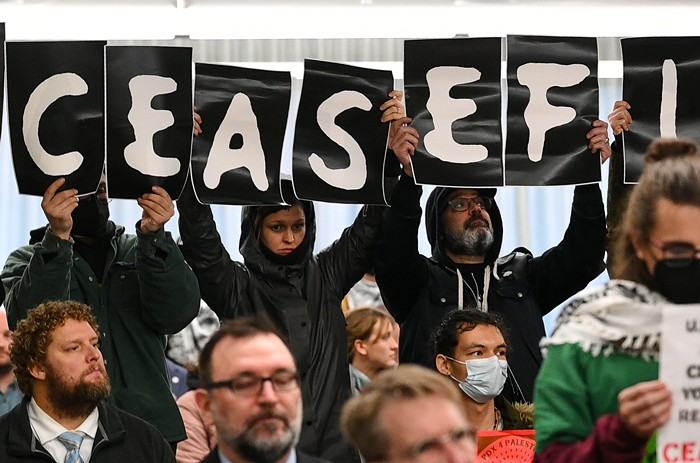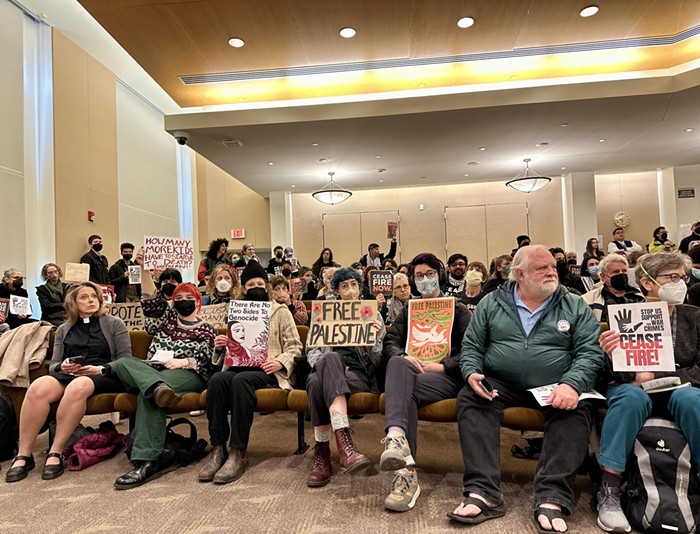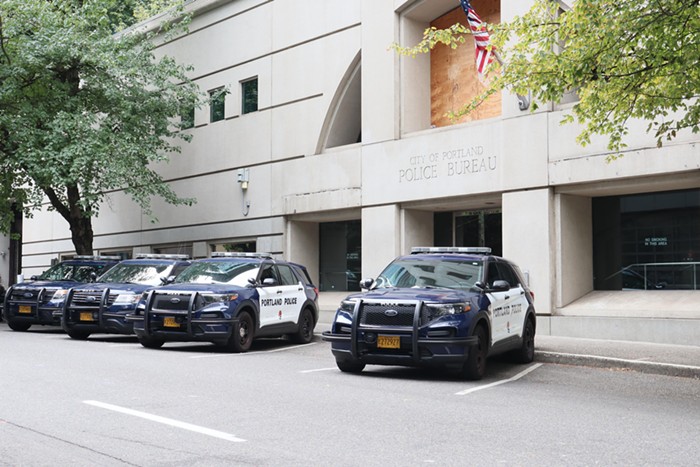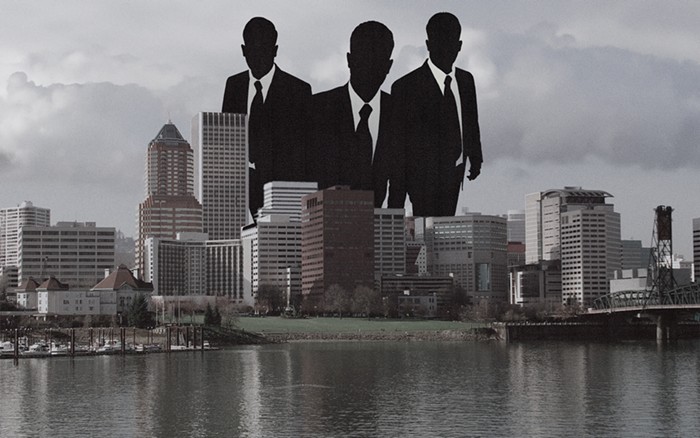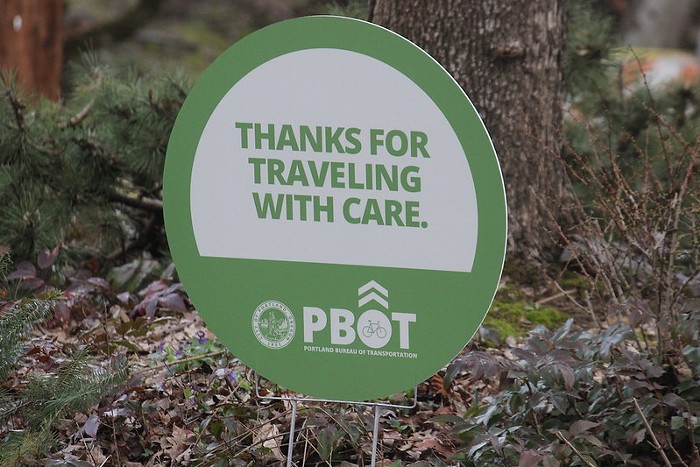Old Town is changing fast, with two major new tenants moving in at the west end of the Burnside Bridge, potentially kicking off a makeover for the entire neighborhood. But hold it! Such makeovers don't always suit the poor or homeless, or those struggling to cope with mental health issues, for whom Old Town has historically been a safe haven. So—who's moving in, and how can we be sure Old Town's evolution doesn't end up displacing the vulnerable people who were there first?
U of Oh, Where's My Camping Spot?
As readers of this newspaper will no doubt be aware, Portland is in desperate need of a flagship journalism school. Fortunately, the University of Oregon started journalism classes on Monday, March 31, in its new premises at the White Stag Building, just north of the Burnside Bridge. More classes for more students across a variety of disciplines will follow in the fall, and there's even a University of Oregon bookstore and "Duck shop" planned.
Until recently, the White Stag Building has lain derelict, its sidewalks on W Burnside playing host in the summer to a variety of homeless folks lined up outside the Portland Rescue Mission next door. The police, who work largely in response to complaints from the community, will now have a stronger reason to move people along who are obstructing the sidewalk.
Coincidentally, on the same day, March 31—as every year—the city's Bureau of Housing and Community Development stopped funding its winter homeless shelters, leaving 90 men and 60 women out on the street on April Fool's Day. (Laughing yet?) In the past, many of those people would have come downtown to set up camp underneath the Burnside Bridge. But U of O's parking lot extends under the bridge, and it's going to be less hospitable for campers from now on.
"I'm not exactly thrilled about it," said Fred, 55, a builder's laborer who has been sleeping at the Salvation Army's Harbor Light emergency shelter for the past three winters. He kept his last name off the record. "The cops have this new sit-lie law, so it's not going to be as easy to roll up in a doorway or sleep under the Burnside Bridge like it used to be.
"One of our favorite places to sleep has traditionally been under the Burnside Bridge," Frank continues, "With the U of O moving in, they don't want to see someone sleeping when they show up for class."
Mercy Mercy, Corps
Meanwhile, on the south side of the Burnside Bridge, development is under way for a new $32 million Mercy Corps headquarters to play host to up to 300 staff, opening in summer 2009. At the moment, 220 staff members are spread across six different offices in Portland, and the organization hopes the new location will allow them to consolidate and expand their efforts.
"Old Town has been through an increase in vibrancy, and there's an emerging sense of vitality that we wanted to be a part of," says the project's manager, Kathy Cook.
Cook says Old Town is developing a "sense of destination," thanks to the Saturday Market and the Chinese Garden, and that Mercy Corps' new Action Center Museum hopes to add to it. The center will seek to engage schoolchildren in global issues of hunger and the causes of poverty, and encourage them to take action.
The Master Plan
Once the Mercy Corps building is in place, one of Old Town's biggest property owners, the Bill Naito Company, will be poised to execute its Old Town/Chinatown "Master Plan," written in July 2007 in collaboration with Ankrom Moisan Architects. The Naito firm owns the block west of the Mercy Corps building, and three and a half blocks between NW Naito, 4th, Couch, and Davis, running west from the river next to the U of O building. The company also owns an adjacent two blocks between NW 1st, NW 3rd, W Burnside, and NW Couch, to the west of the U of O building.
As detailed in the 100-page, 11 x 17-inch document, those blocks could be com- pletely renovated or rebuilt. To take a single block as an example, there's a proposed three-story, 4,750-square-foot office/retail building where the downtrodden Oregon Leather Company Building currently stands at 2nd and Couch. Next door, the historic brick Fleischner Mayer Building incorporates offices and a restaurant, while the parking lot that currently stands on the other half block is slated to turn into a nine-story, 9,500-square-foot workforce housing building.
Naito CEO Bill Balendrick says the plan is on hold for the time being, but he expects things may move forward in 12 to 16 months, if the company's shareholders can agree on it.
Not only did Ankrom Moisan design the Naito Company's master plan, it's hoping to move its own staff of 300 from suburban SW Macadam to a new 125-foot-tall building on Davis between Naito and 1st, next door to the U of O, says Jeff Hamilton, a principal at the firm.
Generosity or Gentrification?
There have been more signs of movement in the Old Town District over recent months, with the city buying the dilapidated Grove Hotel on Burnside, and developer David Gold working with Uwajimaya to locate a supermarket at what is currently a parking lot between NW 4th and 5th, Couch and Davis—he says the deal is good until the end of 2008. There may be nothing like an Asian grocery store to raise property values, but opinion is divided as to whether all the changes afoot in Old Town are necessarily a bad thing for the disadvantaged.
"Broadly speaking, I think [gentrification] is something we should watch out for," says Heather Lyons, who heads the city's Bureau of Housing and Community Development. "But making the whole neighborhood better doesn't mean sweeping homeless people out of the district. A much different Old Town doesn't mean homeless people should have to go somewhere else."
Lyons has been working with outgoing Commissioner Erik Sten, the Portland Development Commission, and the Housing Authority of Portland to site and build the new homeless access center just west of the Greyhound bus station. She also says the neighborhood's stated goal of having at least a 50 percent mix of affordable housing, agreed on by the Old Town Visions Committee, should ensure a continued healthy mix in the future.
Dave Otte is designing the new homeless center for Holst Architects, and says the two words constantly being used in its design are "beauty" and "dignity."
"If you give people a beautiful place to be, they take care of it," he says. "And designing a building with a sense of dignity helps people lift themselves up."
Asked whether he sees the changing face of Old Town as gentrification, Otte disagrees.
"One of the things the Pearl District understands is that you can kick-start an area by getting a diverse group of people established there," he says. "Once you get the diversity in, the rich people follow."
Others are less optimistic.
"Old Town/Chinatown will continue to gentrify," says Genny Nelson, co-founder of the nonprofit Sisters of the Road, which has a café that caters mainly to homeless people. "The question is, will it continue to tell and own the truth of its history as the gateway and first home for so many Portlanders not welcome or even allowed elsewhere in the city?"
"The future of the next 20 years in Portland is being played out in Old Town," says Mike Thelin, who writes the Burnside Blog on portlandspaces.net, which tracks development trends in Portland. "It won't be another Pearl District, where auto shops became coffee shops. In Old Town, people are going to get displaced.
"The real gentrification, the kind that's happened in real cities across the country, is starting to happen in Old Town," Thelin continues. "There's no question about it."
Clash of Cultures
While some speak of lifting up the district, others see obvious risks in beautifying an ugly part of town.
"The city's unstated policy in Old Town seems to be to move the problem population out and to disperse them across the community to make them less visible," says Jason Renaud, an activist with the Mental Health Association of Portland, who has been a volunteer in various Old Town social service organizations since 1979.
"The fact is that the [social] service providers have been in Old Town a lot longer than the gentrifiers," says attorney Monica Goracke of the Oregon Law Center, who co-chairs the mayor's Street Access for Everyone committee. "And there's going to be an awful lot of pressure on that area as it changes.
"In other neighborhoods downtown, there have been clashes between clients of service providers and new residents," Goracke continues. "And this could happen in Old Town unless people are willing to compromise."
One such clash took place in the Pearl District in 2006, when schizophrenic James Chasse—who lived at the Helen M. Swindells Building on the edge of Old Town—was apprehended by police officers opposite the upscale Bluehour restaurant on the corner of NW 13th and Everett in the Pearl.
In his interview with internal affairs detectives after Chasse died mysteriously while in police custody, Officer Christopher Humphreys told them he'd decided to stop Chasse because he thought he'd seen him pissing in the street—and that doing so in a revitalized neighborhood could be bad for business.
"And then, you know... he's urinating in public... in that area we're starting to get into," Humphreys said, according to his taped statement transcription, released by the district attorney. "I mean, that whole area is kinda a high-density area and now we're getting into that revitalized... you know, there's restaurants, there's businesses, and it's a Sunday afternoon."
Best Intentions
The best way to mitigate a clash of cultures in Old Town is for everyone to be a good neighbor, and fortunately, everyone with their eyes on the district seems to have a good grasp of the issues they may face when they move in.
"I think the good news is that all the new residents are really a good fit for Old Town/Chinatown," says Jan Payton Oliver, associate vice president for institutional affairs with the University of Oregon—who has been participating actively in neighborhood meetings in the district over recent months. "When you look at a university community, they tend to be very liberal. It's a community that has succeeded in Eugene very comfortably with a wide variety of challenges and neighbors."
Josh Collins, who is studying for an MA in strategic communications at the new U of O, agrees. Standing in the lobby of the building on Monday night, March 31, sipping a latte, he said he hopes the university moving in will have a positive impact on the neighborhood "without negating any of the positives that are already here."
"We're actually in the business of helping that community feel empowered," says Cook, with Mercy Corps, referring to the downtrodden. "We're aware that it's a neighborhood not unlike some of the most dangerous communities some of our volunteers work in around the world, and we'll be working hard on that synergy."
"We actually like the whole idea of the mixed culture," says Hamilton of Ankrom Moisan Architects. "It's a real city. Sure, there are homeless people in Old Town... but we're not looking to move people out of the neighborhood. We're looking to make it better for everyone."
Big Town Turns into Big City
Perhaps it's premature to predict rioting in the streets as Old Town changes. It seems one of the district's biggest assets in making the transition to the 21st century is its history of being a tolerant community.
Peter Englander at the Portland Development Commission is adamant that his organization is not just serving those who want to gentrify the district.
"When I came to start working in this district three years ago, we decided we want to change the character of this neighborhood in a way that makes it a viable alternative for some folks, but not by pushing people out," Englander says.
His vision for the district is for regular Portlanders to be able to come into Old Town without being afraid of the "very, very poor people" who live there, currently.
"I think you're right to acknowledge the likelihood of tension—the challenge is for everybody engaged on all sides to make it work, as neighbors," says Tom Miller, chief of staff for City Commissioner Sam Adams, who has been working to woo the Oregon College of Oriental Medicine into Old Town, along with other medicine schools like the Linfield College School of Nursing and Health Sciences, and Portland's College of Natural Medicine.
Miller says there is no question that the success of the Pearl District has been a key catalyst in getting people to think "maybe now is the time for Old Town." Nevertheless, he acknowledges that the threat of gentrification is going to be a "huge issue" when thinking about what to do with the district—and Portland itself.
"But that's not necessarily something that's the city [government's] responsibility," he continues. "I mean... that's urban life."
"Everybody is just going to have to figure out how to get along down there," says the police bureau's Central Precinct Commander Mike Reese, whose officers will ultimately have to keep the peace in the neighborhood as the upheaval continues.
Let's hope his optimism is rewarded.

